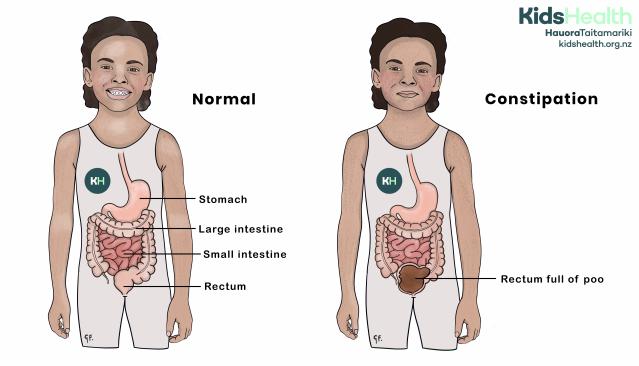Key points about constipation treatment in children
- many tamariki with constipation get better with things you can do at home
- drinking water, eating lots of fruit and veges and regular activity all help
- regularly sitting on the toilet in the morning is also helpful
- some tamariki need laxatives for several months to help their constipation

An illustration of a young child with a normal bowel and a young constipated child with a rectum full of poo.
Source: KidsHealth
transcribeTranscript
This illustration compares a normal digestive system with one experiencing constipation.
- On the left, the child has a normal bowel. The label says 'Normal'. You can see the digestive system: the stomach, small intestine, large intestine, and rectum. The rectum is empty.
- On the right, the child is constipated. The label says 'Constipation'. The digestive system is the same, but the rectum is full of poo that hasn't come out.
The illustration helps show how the digestive system works and what it looks like when there is constipation.
At the top right is the KidsHealth logo with the website: kidshealth.org.nz.
To learn more about symptoms and causes of constipation, see the constipation page.
Treating constipation
-
…
Things you can do at home
- encourage your child to drink plenty of water
- encourage your child to eat lots of fruit and veges
- encourage your child to keep active
- encourage your child to sit on the toilet for several minutes in the morning - even if they don't do a poo, still encourage this
- you could try giving your child prunes or KiwiCrush (a kiwi fruit drink) daily
KiwiCrush and some medicines for constipation are high in sugar. Make sure your child brushes their teeth afterwards.
Fruit and veges
Fruit and veges are high in fibre. Fibre makes poo softer and easier to pass.
To add more fibre to your child's diet, you can:
Give your child at least 5 servings of fruit and veges each day.
Other foods that are high in fibre include:
- some cereals such as Weet-Bix and bran cereals
- porridge
- wholemeal bread
- beans and peas
Give your child plenty of water when increasing fibre in their diet.
Sitting on the toilet regularly
Encourage your child to sit on the toilet for several minutes in the morning. Even if they don't do a poo, still encourage this.
Make sure your child is comfortable sitting on the toilet. Make the toilet interesting and child-friendly with books and toys.
It may help to use a child's toilet seat for preschoolers.
For younger tamariki put a stool under their feet so their knees are higher than their hips. Encourage your child to lean forward and rest their elbows on their knees.
Star charts can help encourage your child to sit on the toilet regularly.
When to get medical help for constipation
Call Healthline on 0800 611 116 or see a health professional if:
- your child has tummy pain
- the constipation is getting worse
- your child finds toileting very upsetting
- your child is having poo accidents
You may need to see your health professional again if the constipation doesn’t get better.
Your health professional may give your child medicine to help their constipation. These are called laxatives.
What are laxatives?
Laxatives are medicines that make it easier to pass poo. They are important for treating long-lasting constipation and poo accidents (soiling).
See the laxatives page to learn more.
Acknowledgements
Illustration by Dr Greta File. Property of KidsHealth.
